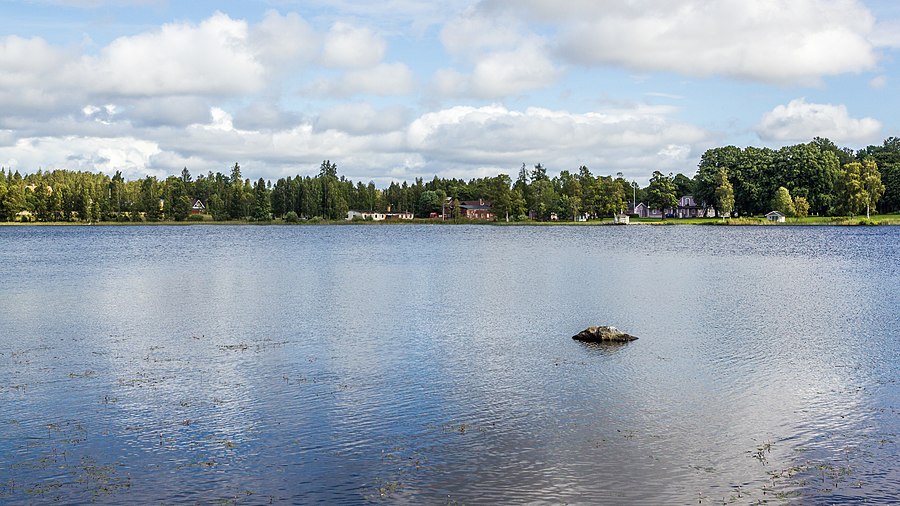

The Angerstein family is a German- Swedish family from Angerstein, Niedersachsen, Holy Roman Empire, [1] with indications of ultimate origins from Hungary. [2]
The Swedish branch immigrated through Anders Angerstein (1614-1659), along with accompanying smiths. In time, Anders Angerstein settled by the Angerstein forge in Vikmanshyttan, Dalarna. His issue extended the holdings, including Vira bruk, Thurbo, and Bispberg, inter alia, [3] with craft production authorisation by the Swedish Board of Mines, [4] remaining in the family until the 19th century. Donations were extended to cultural heritage protected interiors of the Hedemora church in the Diocese of Västerås. [5]
In 1981, the former Angerstein steelworks were transformed into the Steelworks Museum of Vikmanshyttan, maintained as a museum of regional industrial history. [6]
Members in selection
- Anders Angerstein (1614-1659), German-Swedish ironmaster
- sv:Johan Angerstein (1646-1716), Swedish ironmaster
- Johan Angerstein (1672-1720), Swedish assessor
- Reinhold Angerstein (1718–1760), Swedish metallurgist, and entrepreneur
- sv:Uno Angerstein (1808-1874), Swedish officer, industrialist, artist
See also
- Angersteingatan, Solhaga
References
- ^ "Angerstein, släkt - Svenskt Biografiskt Lexikon".
- ^ "Familientreffen: Gelebte Familiengeschichte seit vielen Jahrzehnten | SHZ.de". 13 May 2022.
- ^ "Släkten Angerstein". 22 February 2012.
- ^ "Angersteinska smedjan togs i bruk 1798". 16 March 2012.
- ^ "Kyrkan betydde mycket för släkten Angerstein". 2 September 2013.
- ^ "Home". bruksmuseum.se.
External links
- Gamla Vikmanshyttan (Swedish)
- Steelworks Museum of Vikmanshyttan (Swedish)


The Angerstein family is a German- Swedish family from Angerstein, Niedersachsen, Holy Roman Empire, [1] with indications of ultimate origins from Hungary. [2]
The Swedish branch immigrated through Anders Angerstein (1614-1659), along with accompanying smiths. In time, Anders Angerstein settled by the Angerstein forge in Vikmanshyttan, Dalarna. His issue extended the holdings, including Vira bruk, Thurbo, and Bispberg, inter alia, [3] with craft production authorisation by the Swedish Board of Mines, [4] remaining in the family until the 19th century. Donations were extended to cultural heritage protected interiors of the Hedemora church in the Diocese of Västerås. [5]
In 1981, the former Angerstein steelworks were transformed into the Steelworks Museum of Vikmanshyttan, maintained as a museum of regional industrial history. [6]
Members in selection
- Anders Angerstein (1614-1659), German-Swedish ironmaster
- sv:Johan Angerstein (1646-1716), Swedish ironmaster
- Johan Angerstein (1672-1720), Swedish assessor
- Reinhold Angerstein (1718–1760), Swedish metallurgist, and entrepreneur
- sv:Uno Angerstein (1808-1874), Swedish officer, industrialist, artist
See also
- Angersteingatan, Solhaga
References
- ^ "Angerstein, släkt - Svenskt Biografiskt Lexikon".
- ^ "Familientreffen: Gelebte Familiengeschichte seit vielen Jahrzehnten | SHZ.de". 13 May 2022.
- ^ "Släkten Angerstein". 22 February 2012.
- ^ "Angersteinska smedjan togs i bruk 1798". 16 March 2012.
- ^ "Kyrkan betydde mycket för släkten Angerstein". 2 September 2013.
- ^ "Home". bruksmuseum.se.
External links
- Gamla Vikmanshyttan (Swedish)
- Steelworks Museum of Vikmanshyttan (Swedish)
